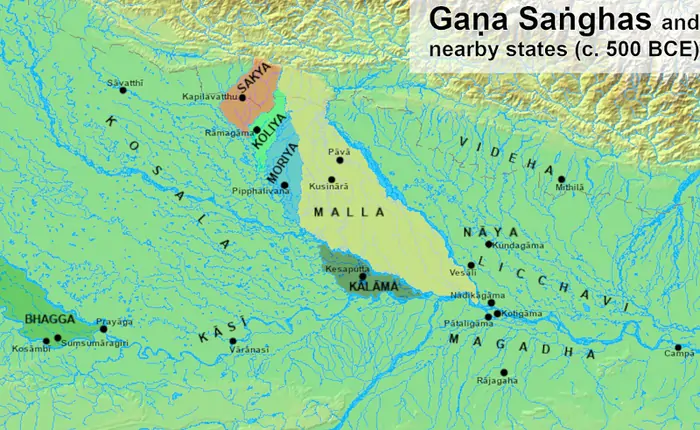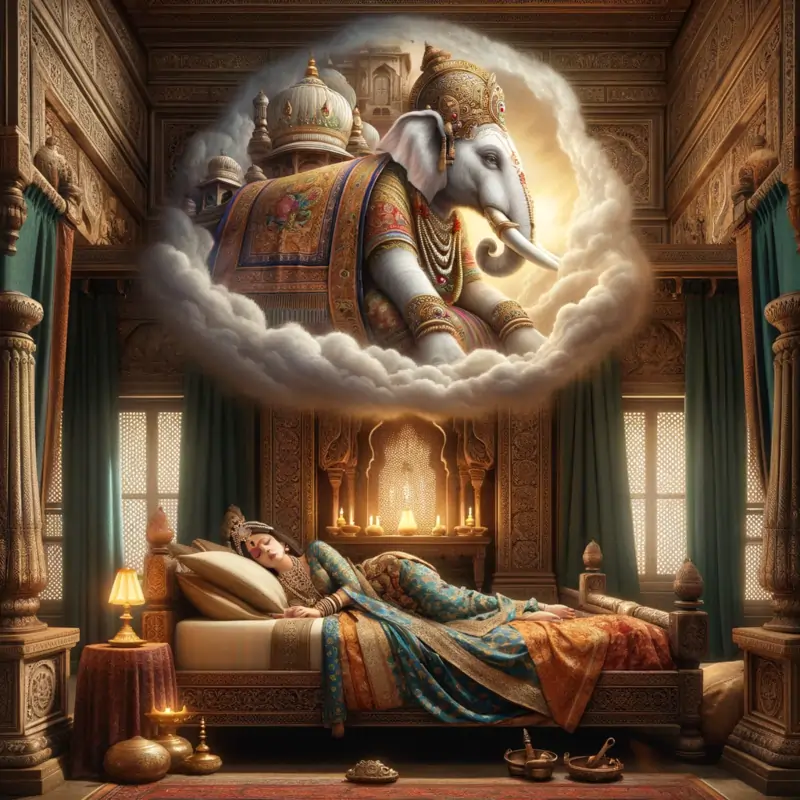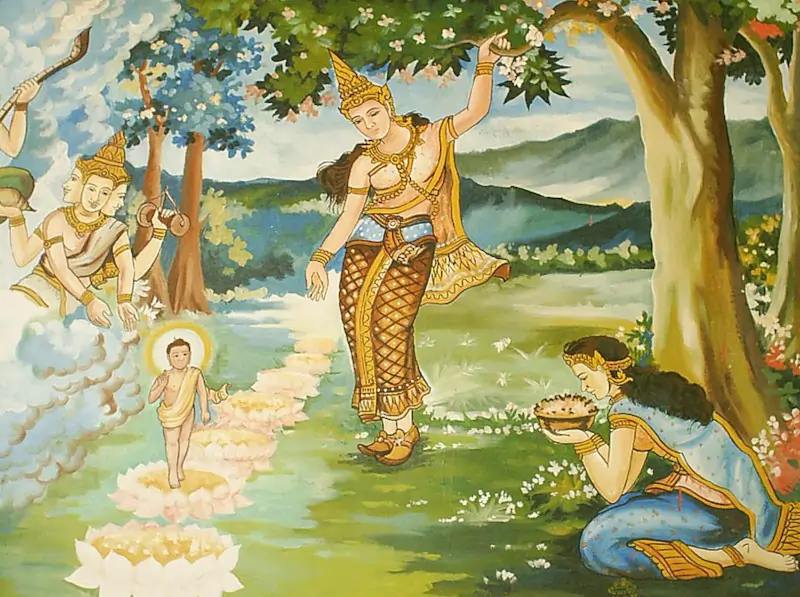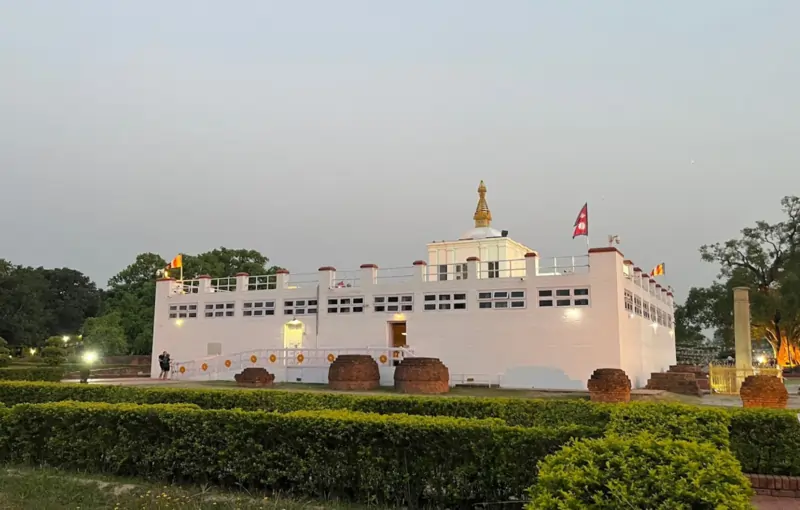The Enchanted Beginnings of a Great Being
Centuries ago during the 6th Century B.C., King Suddhodana, revered as a wise and compassionate ruler, governed the Sakya kingdom, also spelled as Shakya, now part of the modern-day border of Nepal and India. His kingdom, known for its prosperity and peace, had its capital at Kapilavastu ( See in Map), located in today’s Lumbini Province of Nepal. In a union that symbolized the harmony between neighboring realms, King Suddhodana married the stunning Princess Maya Devi, also known as Maha Maya, from the Koliya kingdom, which is now situated in present-day India. The royal couple, deeply admired and cherished by their subjects for their benevolence and just rule, faced a personal longing – the absence of an heir. Despite their prosperity and kindness, their wish for an heir remained unfulfilled, until one mystical night set their destiny in motion.

A Dream That Foretold Destiny
On a radiant full moon night, Queen Maya Devi experienced a dream so vivid it seemed like another reality. She envisioned being escorted by divine beings to a celestial lake, where she was bathed and adorned in heavenly attire. The climax of her dream was marked by the appearance of a white elephant, symbolizing purity and majesty, which circled her thrice before vanishing. This extraordinary dream left the Queen and King Suddhodana in awe.

The Prophecy of the Wise
Puzzled by the dream’s significance, King Suddhodana consulted sages who proclaimed a joyous revelation: the Queen would bear a child of unparalleled purity and greatness. Extremely happy, the royal couple shared their fortune with their subjects, ensuring even the needy were part of their celebration, displaying their inherent compassion and benevolence.
A Journey and a Miraculous Birth
Approximately ten months following a significant dream, Queen Maya Devi, pregnant and observing traditional customs, requested to return to her parental home. In response, King Suddhodana organized a grand procession: he dispatched soldiers to clear the path and assigned a contingent to protect the Queen, who journeyed in a splendidly decorated palanquin. Leaving Kapilavastu, the entourage made its way toward the Koliya kingdom.
En route, they traversed a captivating garden located at the Himalayas’ base. This serene park, abundant with sweet-scented flowers on Sala trees (Sal Tree) and teeming with wildlife, beckoned the Queen to rest. It was under one of these Sala trees that she gave birth to a son, on a significant full moon day in the Baishakh month of 566 B.S. (Baishakh is the first month of Bikram Sambat a.k.a. B.S.), or 623 B.C. This place is now known as the Maya Devi Temple in Lumbini, Nepal, ( See in Map), a must-visit Buddhist destination where Buddha was born. Legends surrounding this momentous birth tell of the newborn taking seven steps, each marked by the miraculous appearance of a lotus flower, symbolizing purity and divinity. Moreover, the infant purportedly proclaimed his preeminence and the finality of his earthly journey, declaring, “I am the chief in the world. There is no equal to me. I am supreme. This is my last birth. No Rebirth for me.” These extraordinary events and declarations have been subject to various interpretations, adding layers of mystique and reverence to this historical narrative.

Joy and Naming of the Prince
Following the momentous birth of her son, Queen Maya Devi swiftly journeyed back to Kapilavastu, the heart of their kingdom. The news of her safe return and the arrival of the newborn prince filled King Suddhodana with immense joy, a sentiment that quickly spread throughout the nation. The people of their realm, sharing in the royal family’s happiness, celebrated with great enthusiasm. In a significant gesture, the King and Queen named their long-awaited heir Prince Siddhartha Gautam Shakya, a name that would resonate through history and across cultures, symbolizing hope, enlightenment, and a new era for their kingdom.
Unraveling the Birthplace of Buddha: A Geographical Mystery
The origins of Prince Siddhartha Gautam, famously known as Buddha, have long been shrouded in geographical ambiguity. Historically, it’s believed that he was born southeast of the ancient city of Kapilavastu, now the site of the renowned Maya Devi Temple ( See in Map), a significant pilgrimage destination for Buddhists. During Buddha’s time, the landscape was divided into distinct kingdoms, with his father ruling the Sakya country, an area presently split between Nepal and India. Today, Kapilavastu, the capital of this ancient kingdom, resides within Nepal’s borders. The exact location where Queen Maya Devi, Buddha’s mother, gave birth to him is also in Nepal, famously marked by the Maya Devi Temple. This was testified by the inscription on the pillar erected by the Mauryan Emperor Asoka in Lumbini in 249 BC, UNESCO. This historical and geographical puzzle has fascinated scholars and devotees alike, as they navigate the intricate tapestry of ancient kingdoms to pinpoint the birthplace of one of the world’s most revered spiritual figures.

Location Map of Buddha’s Birthplace
Conclusion: The Start of a Spiritual Odyssey
The birth of Prince Siddhartha, who would later be known as Buddha, intertwines history with mythology, painting a vivid picture of a remarkable beginning. His journey from a prince to an enlightened being continues to inspire and guide millions across the world, making his story a timeless treasure. As Buddha originated from the Shakya clan, he is often known as Shakyamuni Buddha, signifying “Sage of the Shakya Clan”.
Frequently Asked Questions
1. Who was King Suddhodana and where was his kingdom?
King Suddhodana, celebrated for his wisdom and compassion, ruled the Sakya kingdom around 600 B.C., located in the area that is now the border of Nepal and India. His capital, Kapilavastu, is in present-day Lumbini Province, Nepal.
2. What is significant about Queen Maya Devi’s dream?
Queen Maya Devi’s dream, where she saw a white elephant circling her thrice, symbolized purity and majesty. It was interpreted as a divine sign that she would bear a child of great purity and greatness.
3. What were the customs followed by Queen Maya Devi during her pregnancy?
Following traditional customs, Queen Maya Devi requested to return to her parental home in the Koliya kingdom (which is south of the Sakya kingdom) for childbirth, a journey marked by a grand procession organized by King Suddhodana.
4. Where was Buddha born and what are the legends surrounding his birth?
Buddha was born under a Sala tree in a garden at the base of the Himalayas, now the site of Maya Devi Temple in Lumbini, Nepal. Legends say he took seven steps at birth, each marked by a lotus flower, symbolizing purity and divinity. The birthplace of Buddha was testified by the inscription on the pillar erected by the Mauryan Emperor Asoka in Lumbini, Nepal in 249 BC, UNESCO.
5. What is the geographical mystery surrounding Buddha’s birthplace?
The birthplace of Buddha, believed to be southeast of ancient Kapilavastu, now the Maya Devi Temple in Lumbini, Nepal, has been a subject of fascination due to the division of the ancient Sakya kingdom between modern Nepal and India.
6. What is the significance of Buddha’s story in modern times?
Buddha’s journey from prince to enlightened being remains a source of inspiration and guidance, symbolizing hope and enlightenment, and his story is considered a timeless treasure.
7. Why is Buddha Called Shakyamuni?
‘Shakyamuni’ literally translates to ‘Sage of the Shakya clan’. This title is used to refer to Buddha due to his birth in the Shakya clan.
8. What is Buddha’s birth name?
Buddha’s birth name is Siddhartha Gautam Shakya. He was born as a prince of the Shakya clan in 623 BC.
Reference
- Four Novel Truths, Dan Shobha Tuladhar, Dipankar Tuladhar, 2017
- Sakya, Wikipedia.org
- Lumbini, the Birthplace of Lord Buddha, UNESCO.org
- Life of the Buddha, The Metropolitan Museum

